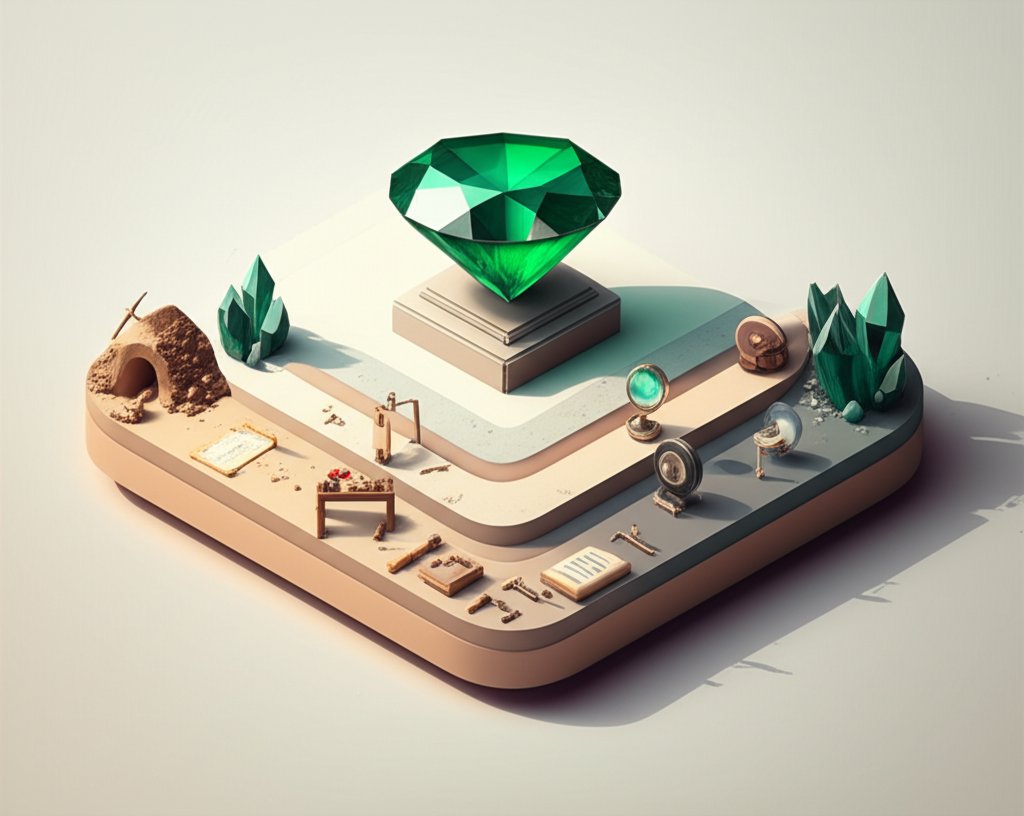Embark on a captivating journey into the dazzling world of gemstones, where Earth’s most breathtaking treasures reveal their secrets. From the captivating sparkle of diamonds to the deep allure of sapphires, gemstones have enchanted humanity for millennia. This comprehensive guide will explore fascinating gemstone facts, delve into their rich gemstone history, and equip you with the knowledge for practical gemstone identification. Whether you’re a budding enthusiast, a seasoned collector, or simply curious about these magnificent precious stones, prepare to uncover the allure, science, and lore that make each gem a unique marvel.
What Are Gemstones? Unveiling Earth’s Natural Wonders
At their core, gemstones are naturally occurring minerals, rocks, or organic materials that have been chosen for their beauty, durability, and rarity, then cut and polished for use in jewelry or other adornments. Their formation stories are as varied and ancient as the Earth itself, often involving immense pressure, heat, and complex chemical processes deep within the planet’s crust.
Defining Precious Stones vs. Semi-Precious Gemstones
Historically, a distinction was often made between “precious stones” and “semi-precious stones.” Traditionally, the “Big Four” – diamonds, rubies, sapphires, and emeralds – were classified as precious stones due to their extreme rarity, exceptional beauty, and significant historical value. All other gemstones were then grouped as semi-precious.
However, this classification is largely outdated and can be misleading. The value of a gemstone today is determined by many factors (rarity, quality, demand, size, and origin), not just its historical category. For instance, a high-quality demantoid garnet (traditionally semi-precious) can be far more valuable than a low-quality emerald. Modern gemology prefers to evaluate each stone on its individual merits rather than relying on an arbitrary historical hierarchy. Nonetheless, the term “precious stones” endures as a general descriptor for highly valued gems.
How Gemstones Form: A Journey from Earth’s Depths to Dazzling Beauty
The creation of gemstones is a testament to the Earth’s dynamic geological processes, each type forming under specific conditions:
- Igneous Formation: Many gemstones crystallize from molten rock (magma or lava) as it cools. Diamonds, for example, form deep within the Earth’s mantle under extreme pressure and temperature, then are brought to the surface by volcanic eruptions. Topaz and some tourmalines also form in igneous intrusions.
- Metamorphic Formation: Intense heat and pressure can transform existing minerals into new forms. Rubies and sapphires (both corundum) are often found in metamorphic rocks, where existing aluminum-rich minerals are recrystallized. Emeralds can also form in metamorphic environments.
- Sedimentary Formation: Some gemstones form when minerals precipitate from aqueous solutions, often within sedimentary rocks. Opals, for example, form from silica-rich water seeping into cracks and voids.
- Hydrothermal Formation: Hot, mineral-rich water circulating through cracks and fissures in rocks can deposit minerals as it cools. Amethyst, citrine, and quartz varieties often form this way.
- Organic Formation: A unique category, organic gemstones are produced by living organisms. Pearls form within mollusks, while amber is fossilized tree resin. Coral is the skeletal remains of marine polyps. These gemstones offer a different kind of beauty, rich in natural textures and historical significance.
Unearthing Gemstone Facts: Properties and Characteristics
Understanding the fundamental characteristics of gemstones is essential for appreciating their beauty, assessing their value, and even performing rudimentary gemstone identification. These properties define each gem’s unique appeal and durability.
The 4 Cs of Gemstones: A Universal Grading System
While most famously applied to diamonds, the “4 Cs” provide a universal framework for evaluating many other precious stones:
- Carat: This refers to the gemstone’s weight (1 carat = 200 milligrams). Larger gemstones are generally rarer and more valuable, assuming other factors are equal.
- Color: For most gemstones, color is the most crucial factor influencing value. Hue (the actual color), tone (lightness or darkness), and saturation (intensity or purity) all play a role. The most desirable colors are typically vibrant and richly saturated without being overly dark.
- Clarity: This describes the absence of internal inclusions (blemishes within the stone) and external imperfections (surface flaws). Fewer and smaller inclusions generally mean higher clarity and greater value, though some inclusions can add character or prove origin.
- Cut: The cut of a gemstone refers not to its shape (e.g., round, oval), but to how well its facets are proportioned and polished. A skilled cut maximizes the stone’s brilliance, fire (dispersion of light into spectral colors), and scintillation (sparkle as the stone moves). A well-cut gem will reflect light optimally to the viewer’s eye.
Hardness (Mohs Scale) and Durability: Resilience and Wearability
The Mohs scale of mineral hardness, ranging from 1 (talc) to 10 (diamond), measures a gemstone’s resistance to scratching. This is a critical gemstone fact for practical wear:
- Diamond (10): The hardest naturally occurring substance, making it exceptionally durable for everyday wear.
- Corundum (Ruby, Sapphire – 9): Very hard and suitable for all types of jewelry.
- Topaz, Aquamarine (8): Good hardness for most jewelry.
- Quartz (Amethyst, Citrine – 7): Still quite durable, but can scratch with proper care.
- Feldspar (Moonstone – 6-6.5): Requires more care to prevent scratching.
- Organic Gems (Pearl, Amber – 2.5-4.5): Much softer, requiring delicate handling and protective settings.
Durability also encompasses toughness (resistance to breaking or chipping) and stability (resistance to chemical or temperature changes). Some gemstones, while hard, can be brittle (like tanzanite), while others might fade with prolonged sun exposure (like amethyst).
Optical Properties: Luster, Refraction, and Dispersion
The way light interacts with a gemstone gives it its visual appeal:
- Luster: The quality and intensity of light reflected from a gemstone’s surface. Terms like adamantine (diamond-like), vitreous (glassy), silky, or pearly describe different lusters.
- Refraction: The bending of light as it passes through a gemstone. This is measured by the refractive index (RI) and is a key tool in
gemstone identification. Some gems are single refractive (light passes through at one angle), others are double refractive (light splits into two angles), and some are aggregate (like chalcedony). - Dispersion (Fire): The splitting of white light into its spectral colors (like a rainbow). Diamonds are famous for their high dispersion, creating dazzling “fire.”
- Pleochroism: The phenomenon where a gemstone appears to be different colors when viewed from different angles (e.g., tanzanite).
- Phenomena: Some gemstones exhibit unique optical effects, such as asterism (star effect in sapphires, rubies), chatoyancy (cat’s eye effect), adularescence (moonstone’s glow), or iridescence (opal’s play-of-color). These add significant value and are vital
gemstone factsfor appreciation and identification.
A Rich Gemstone History: From Ancient Talismans to Modern Treasures
The gemstone history is intrinsically interwoven with human civilization, reflecting shifts in power, culture, and belief. From prehistoric adornments to royal regalia, precious stones have played significant roles across every continent and era.
Ancient Civilizations and Early Uses of Precious Stones
The earliest evidence of gemstones being used dates back tens of thousands of years, with simple shells and stones fashioned into amulets. As civilizations advanced, so too did the use and significance of gemstones:
- Ancient Egypt: Egyptians revered gemstones for their beauty and symbolic power. Lapis lazuli, turquoise, carnelian, and emeralds adorned pharaohs, queens, and their elaborate tombs. They believed these gems provided protection in the afterlife and connected them to deities. Scarabs carved from various stones were powerful talismans.
- Mesopotamia and Persia: Early Mesopotamian cultures used cylinder seals carved from lapis lazuli, carnelian, and quartz for identification and as mystical objects. Persians introduced the world to the brilliance of rubies and sapphires from their mines.
- Ancient Greece and Rome: Greeks believed amethyst could ward off intoxication, while Romans associated diamonds with eternity and courage. Gemstones were widely used in rings, pendants, and elaborate imperial jewelry, often engraved with intaglios or cameos. They also documented
gemstone factsand properties in early lapidaries. - Pre-Columbian Americas: Civilizations like the Maya, Aztec, and Inca highly valued jade, turquoise, and obsidian, using them for religious ceremonies, elaborate ornamentation, and tools. They believed these
precious stonesheld spiritual power. - Ancient China: Jade holds paramount importance in Chinese culture, symbolizing purity, wisdom, and nobility. It was used for tools, ceremonial objects, and burial rites thousands of years ago, long before diamonds were widely known in the West.
Medieval and Renaissance Gemstone Lore
During the Middle Ages, gemstones were not only symbols of wealth and status but were also imbued with powerful mystical and medicinal properties. This period of gemstone history saw a surge in lapidaries – books detailing the magical and healing powers of various stones.
- Amulets and Talismans: Gemstones were often worn as protection against evil, illness, or witchcraft. Rubies were believed to grant invulnerability, sapphires to promote wisdom and truth, and emeralds to improve eyesight and foresight.
- Religious Significance: Many gemstones found their way into religious artifacts, reliquaries, and priestly garments, symbolizing divine attributes or biblical narratives. The breastplate of the High Priest in the Bible, for example, featured twelve different
precious stones, each representing a tribe of Israel. - Royal and Aristocratic Adornment: Crowns, scepters, and ceremonial jewelry were heavily embellished with gemstones, signifying power, divine right, and immense wealth. The art of gem cutting began to evolve, moving beyond simple polishing to more intricate faceting.
The Age of Exploration and New Discoveries
The Renaissance and subsequent Age of Exploration profoundly impacted gemstone history. New trade routes and discoveries of vast mineral deposits in newly charted lands revolutionized the availability and variety of gemstones in Europe.
- Indian Diamonds: While India had been the primary source of diamonds for centuries, increased trade introduced larger quantities to the European market.
- South American Abundance: The discovery of vast emerald mines in Colombia and later diamond mines in Brazil in the 18th century shifted the global supply chain, making these
precious stonesmore widely available. - New Varieties: Explorers brought back exotic gemstones previously unknown or rare in the West, such as peridot, tanzanite (much later), and new varieties of tourmaline and garnet, expanding the palette available to jewelers.
Modern Gemstone Industry and Trends
The 19th and 20th centuries saw the industrialization of mining, advancement in gemology (the scientific study of gemstones), and sophisticated cutting and polishing techniques.
- Scientific Gemology: The establishment of institutions like the Gemological Institute of America (GIA) brought scientific rigor to gemstone identification and grading, setting standards for the industry.
- Synthetics and Treatments: The ability to create synthetic gemstones and enhance natural ones through various treatments (heat, irradiation) became widespread. This necessitated stricter
gemstone identificationmethods and clear disclosure by sellers. - Global Sourcing & Ethical Concerns: Today, gemstones are sourced from nearly every continent. Awareness of ethical mining practices, fair trade, and conflict-free sourcing has become increasingly important to consumers.
- Investment & Collectibles: Beyond jewelry, rare and exceptional gemstones are increasingly viewed as investment assets and collector’s items, with prestigious auctions fetching record-breaking prices.
Mastering Gemstone Identification: A Practical Guide
Accurate gemstone identification is a critical skill for buyers, sellers, and enthusiasts alike. While a definitive identification often requires specialized equipment and expertise, understanding key characteristics and basic methods can greatly assist in distinguishing between different precious stones.
Essential Tools for Gemstone Identification
For the hobbyist or curious beginner, a few basic tools can aid significantly in preliminary gemstone identification:
- 10x Loupe: An essential magnifying tool (10x magnification is standard) to inspect internal inclusions, surface characteristics, and cutting quality.
- Tweezers: For safely handling gemstones without leaving fingerprints or causing damage.
- Gem Cloth: A soft, lint-free cloth for cleaning gemstones and ensuring clear observation.
- Gemstone Reference Books/Charts: Comprehensive guides detailing the properties (hardness, refractive index, specific gravity, typical inclusions) of various gemstones.
- Penlight/Mini Flashlight: To observe how light interacts with the stone, checking for brilliance, fire, and potential optical phenomena.
- Mohs Hardness Picks (Optional but Recommended): A set of calibrated mineral points to test a stone’s hardness by attempting to scratch it. Caution: Only use on a small, inconspicuous area if necessary, as scratching can damage the gem.
Step-by-Step Gemstone Identification Process
Here’s a simplified approach to gemstone identification for common precious stones:
- Observe Color: What is the exact hue, tone, and saturation? Is the color evenly distributed, or are there color zoning patterns? Compare it to known examples.
- Examine Clarity and Inclusions: Using your 10x loupe, look for internal characteristics. Are there tiny bubbles, crystals, growth lines, or other unique patterns? Some inclusions are diagnostic (e.g., “jardin” in emeralds, rutile needles in sapphires). Be aware of common imitations that might have large bubbles.
- Assess Cut and Luster: How well is the stone cut? Does it sparkle brightly? What is the quality of the surface shine?
- Test Hardness (Carefully!): If unsure and on an unknown specimen, you can try to scratch an inconspicuous edge with a tool of known hardness (e.g., a steel file is ~6.5). If it scratches, the stone is softer. If not, it’s harder. Again, exercise extreme caution.
- Check for Pleochroism: If the stone is suspected to be a gem like tanzanite or iolite, rotate it and observe if the color changes when viewed from different angles. This can be seen with the naked eye or a dichroscope.
- Measure Specific Gravity (Advanced): This involves weighing the stone in air and then in water to determine its density. Each gemstone has a characteristic specific gravity, making it a powerful
gemstone identificationtool, though it requires specialized equipment. - Consider Optical Phenomena: Does the stone show a star effect (asterism), a cat’s eye (chatoyancy), or a play of color (opalescence)? These are strong indicators for specific gemstones.
Recognizing Common Precious Stones: Key Indicators
Here are quick gemstone facts for identifying some popular precious stones:
- Diamond: Highest sparkle (adamantine luster, strong fire), extreme hardness (scratches almost everything), typically clear but can be colored. Common inclusions: tiny crystals, pinpoints.
- Ruby: Red (ranging from purplish-red to orangish-red), very hard (9 on Mohs), often exhibits strong fluorescence under UV light. Common inclusions: “silk” (rutile needles), fingerprints.
- Sapphire: Blue (can be other colors, “fancy sapphires”), very hard (9 on Mohs). Blue sapphires often have color zoning. Common inclusions: “silk,” color banding.
- Emerald: Green (often with a bluish tint), moderate hardness (7.5-8), but often brittle due to many inclusions. The signature “jardin” (garden) of inclusions is characteristic.
- Pearl: Organic, iridescent luster (orient), soft (2.5-4.5 Mohs), spherical or baroque shapes. Surface often has slight irregularities or growth rings under magnification.
- Amethyst (Quartz): Purple, hardness 7, often has color zoning, commonly found in geode formations.
- Topaz: Hardness 8, wide range of colors (blue, yellow, pink, clear). Blue topaz is often irradiated.
- Garnet: Hardness 6.5-7.5, wide variety of colors (red, orange, green), known for strong brilliance. Always single refractive.
- Opal: Characterized by its unique “play-of-color,” relatively soft (5.5-6.5), can be prone to drying out.
The Role of a Gemologist
For definitive and professional gemstone identification and appraisal, consulting a certified gemologist is crucial. They possess advanced knowledge, specialized tools (refractometers, polariscopes, spectroscopes, microscopes), and the experience to accurately identify gemstones, detect treatments, and assess their quality and value. This expertise is particularly vital when dealing with high-value precious stones or when buying from an unknown source.
Beyond Beauty: The Value and Care of Gemstones

The allure of gemstones goes beyond their visual appeal; it encompasses their inherent value, both monetary and sentimental, and the responsibility of proper care to ensure their longevity.
Factors Influencing Gemstone Value
While the 4 Cs provide a framework, several other gemstone facts contribute to a gem’s ultimate market value:
- Rarity: The scarcer a gemstone is, the higher its value. Tanzanite, for example, is rarer than amethyst and commands a higher price because it’s only found in one small region.
- Origin: The source of a gemstone can significantly impact its value. Rubies from the Mogok Valley in Myanmar (Burma) or sapphires from Kashmir are famous for their exceptional quality and command premium prices due to their historical prestige.
- Treatments: Many gemstones are treated to enhance their color or clarity. While some treatments (like heat treatment for sapphires) are common and accepted, others (like dyeing or extensive filling) must be disclosed and can lower value if not natural. Untreated, high-quality precious stones are generally more valuable.
- Demand & Trends: Popularity and fashion trends can fluctuate, influencing demand and thus the price of certain gemstones.
- Size: Larger gemstones of comparable quality are exponentially rarer and thus far more valuable per carat than smaller ones.
- Cutting Quality: Beyond the “cut C,” the skill of the lapidary (gem cutter) can unlock a gem’s full potential, enhancing its beauty and value.
Caring for Your Precious Stones
To preserve the beauty and integrity of your gemstones and extend their lifespan, proper care is essential:
- Cleaning: Most gemstones can be cleaned with warm, soapy water and a soft brush. Avoid harsh chemicals or ultrasonic cleaners for delicate gems like pearls, emeralds (especially treated ones), opals, and turquoise. Always rinse thoroughly.
- Storage: Store gemstones separately to prevent scratching, especially harder gems scratching softer ones. Use individual cloth bags or compartmentalized jewelry boxes. Keep them away from extreme heat or prolonged direct sunlight, which can fade some colors.
- Wear: Be mindful of activities when wearing gemstones. Remove jewelry before strenuous activities, cleaning with chemicals, or swimming. Protect softer gems from knocks and impacts.
- Professional Check-ups: Have your gemstone jewelry inspected periodically by a jeweler to check for loose settings or damage, particularly for everyday wear items.
Conclusion: The Enduring Allure of Gemstones
From their miraculous formation deep within the Earth to their rich gemstone history etched into human culture, gemstones continue to captivate and inspire. We’ve journeyed through essential gemstone facts, explored the scientific and optical properties that make each stone unique, and equipped you with foundational knowledge for gemstone identification. These precious stones are more than just beautiful adornments; they are tangible pieces of our planet’s story, symbols of power, love, and mystery.
Embrace the fascinating world of gemstones! Whether you’re admiring a display, choosing a personal piece, or simply appreciating their natural wonder, the knowledge gained here will deepen your connection to these extraordinary treasures.
FAQ

Q: What is the most important factor in a gemstone’s value?
A: While all the “4 Cs” (Carat, Color, Clarity, Cut) and other factors like rarity and origin play a role, for many gemstones (especially colored ones), color is often considered the most important factor in determining its value. For diamonds, all 4 Cs are typically weighted more evenly.
Q: Can I identify a gemstone at home without special equipment?
A: You can perform preliminary gemstone identification using basic observations (color, clarity, luster, visible inclusions) and simple tools like a 10x loupe. However, definitive identification, especially to distinguish between natural, synthetic, and treated stones, almost always requires specialized gemological equipment and expertise.
Q: Are synthetic gemstones real?
A: Synthetic gemstones are “real” in the sense that they possess the same chemical composition, crystal structure, and physical properties as their natural counterparts. The key difference is their origin: natural gems form in the Earth, while synthetic gems are grown in a laboratory. They should always be disclosed as such.
Q: What is the Mohs scale of hardness and why is it important for gemstones?
A: The Mohs scale is a qualitative ordinal scale from 1 (softest) to 10 (hardest) that characterizes the scratch resistance of various minerals. For gemstones, it’s crucial for understanding their durability and suitability for different types of jewelry. A higher Mohs rating means the gem is more resistant to scratching and more appropriate for everyday wear.
Q: How far back does gemstone history go?
A: The use of gemstones by humans dates back tens of thousands of years, with archaeological evidence showing early humans using shells and simple stones for adornment and symbolic purposes. Organized mining and sophisticated craftsmanship of precious stones emerged with ancient civilizations like the Egyptians, Sumerians, and Chinese, thousands of years ago.
Q: What are some examples of organic gemstones?
A: Unlike most gemstones that are minerals, organic gemstones are formed from living organisms. Key examples include pearls (from mollusks), amber (fossilized tree resin), and coral (skeletal remains of marine polyps). These have unique properties and a distinct place in gemstone history.










